Table of Contents
Struggling to find time or motivation to hit the gym? Maybe the commute is a hassle, or perhaps you just prefer the privacy of your own space. It's a common problem. Finding an effective workout that fits into a packed schedule can feel like a puzzle with missing pieces. You've heard about High-Intensity Interval Training (HIIT) – short, sharp bursts of effort designed to torch calories and build fitness fast. Sounds great, but how do you actually *do* it effectively without a coach yelling at you or fancy gym equipment?
Why Choose a HIIT Workouts at Home App?

Why Choose a HIIT Workouts at Home App?
Ditching the Gym Hassle
Let's be honest, getting to the gym can be a production. There's the packing of the bag, the commute through traffic, finding parking, navigating crowded machines, and maybe even waiting in line for a shower. It eats up time you might not have. A hiit workouts at home app cuts all of that out. Your living room becomes the gym, your schedule dictates the time, and the dress code is whatever you feel like (pajamas are a valid option). You can squeeze in a potent 20-minute session between conference calls or while dinner simmers. No travel time, no waiting around. It’s just you, the app, and the floor.
Pocket-Friendly Fitness and Privacy
Gym memberships aren't cheap. They often come with contracts, hidden fees, and the guilt of paying even when you don't go. Comparing that to the typical cost of a hiit workouts at home app, which is usually a fraction of a monthly gym fee, the financial argument is pretty clear. Plus, some people just aren't comfortable working out in front of others. Maybe you're trying a new move, you sweat like a faucet, or you just prefer to grunt and groan without an audience. An app provides that privacy. Nobody's watching your form (unless your cat is particularly judgmental), and you can make all the weird workout noises you want.
So, why bother with the commute, the cost, or the crowds?
- Save time by eliminating travel.
- Workout on your own schedule, anytime.
- Significantly reduce fitness expenses compared to gym fees.
- Enjoy complete privacy during your workout.
- Forget waiting for equipment or navigating busy spaces.
Key Features to Look For in a HIIT Workouts at Home App

Key Features to Look For in a HIIT Workouts at Home App
Finding Your Perfect Workout Mix and Match
Alright, so you're ditching the gym. Great. But you don't want an app that gives you the same three burpee variations every single day. A top-tier hiit workouts at home app needs variety. We're talking a solid library of exercises, not just bodyweight stuff, though that's crucial for home workouts. Look for apps that let you filter by muscle group, equipment (if you have any, even just dumbbells), difficulty level, and perhaps most importantly, duration. Some days you have 30 minutes, some days you barely have 10. The app should adapt. Can you build custom workouts? Can you swap out exercises you hate (looking at you, jump squats) for ones you tolerate?
Clear Instructions and Tracking Your Gains (or Losses)
Nobody wants to guess what a "sprawl" is halfway through a set. The best apps provide crystal-clear instructions. This usually means video demonstrations, preferably with good form cues, and maybe even audio guidance telling you when to switch or rest. It’s like having a virtual coach, minus the awkward small talk. Beyond just telling you what to do, a good hiit workouts at home app should help you track your progress. Did you do more reps this week? Did you last longer in that plank? Seeing those numbers change, even slightly, is a powerful motivator. If it doesn't track anything, it's just a fancy timer with videos.
What features make a real difference?
- Extensive exercise library with variations.
- Filters for duration, difficulty, and muscle group.
- Option to customize or build your own workouts.
- High-quality video demos and clear audio cues.
- Progress tracking for workouts completed, time, or reps.
- Ability to log mood or energy levels.
User Experience and Staying Motivated
Let's talk about the app itself. Is it clunky? Does it crash mid-burpee set? A good hiit workouts at home app needs a clean, intuitive interface. You should be able to find a workout quickly and start it without hunting through menus. Some apps offer community features – maybe a leader board (if you're competitive) or the ability to share your progress with friends. Others provide motivational tips or reminders. While not strictly necessary for the workout itself, these elements can keep you engaged when your motivation starts to dip. Think about it: if the app is a pain to use, you're less likely to use it, no matter how good the workouts are supposed to be.
Making the Most of Your HIIT Workouts at Home App Sessions

Making the Most of Your HIIT Workouts at Home App Sessions
Setting Up Your Home Workout Zone
you've downloaded your hiit workouts at home app. Now what? Don't just jump into burpees next to your coffee table. Clear some space. You need enough room to swing your arms, lunge, and maybe even flop on the floor dramatically after a tough set. Tripping over the rug or banging your hand on a lamp isn't part of the program. Make sure the floor isn't too hard – a yoga mat or even just a soft carpet helps save your joints. And hydration is key. Keep a water bottle nearby so you're not running to the kitchen mid-session. Think of it as your personal, temporary fitness sanctuary.
Focusing on Form Over Speed
It's called High-Intensity Interval Training, not High-Speed Sloppy Training. The app might be counting down the seconds, but don't sacrifice proper form just to get more reps in. Bad form is how you get injured, and a pulled hamstring will definitely derail your fitness goals faster than anything else. Watch the video demos carefully *before* you start the interval. Pay attention to cues like keeping your back straight during squats or engaging your core during planks. It feels slower at first, sure, but executing movements correctly is more effective and prevents you from hobbling around later. Listen to your body – if something feels sharp and wrong, stop.
Before You Start | During the Workout | After the Workout |
|---|---|---|
Clear adequate space | Prioritize proper form | Hydrate immediately |
Have water ready | Listen to your body | Stretch gently |
Wear appropriate shoes (usually) | Push your intensity safely | Log your progress in the app |
Staying Consistent and Tracking Progress
One session with your hiit workouts at home app won't magically transform you. Consistency is the boring, often-ignored secret sauce. Aim for a realistic schedule – maybe three or four sessions a week. Don't beat yourself up if you miss one, just get back on track for the next. Use the app's tracking features, if it has them. Seeing that you've completed 10 workouts this month, or that you held that wall sit for 10 seconds longer than last week, provides tangible proof that you're actually doing something. This feedback loop, seeing small wins stack up, is crucial for long-term motivation when the initial novelty wears off.
Comparing Types of Home HIIT Apps

Comparing Types of Home HIIT Apps
Freebie Finds vs. Subscription Services
so you've decided to give this whole hiit workouts at home app thing a shot. Your first stop is probably the app store, and bam – a million options. You'll quickly notice a split: the free apps and the ones that want your credit card info monthly or yearly. The free ones can be a decent starting point. They often offer a few basic workouts, maybe a challenge, and let you dip your toes in without commitment. Think of them as the sample tray at the grocery store. You get a taste, see if you like the flavor of HIIT, and if the app's interface doesn't make you want to throw your phone. However, they often lock the best features, the wider workout library, and detailed tracking behind a paywall. You might hit a ceiling pretty fast if you stick only to the free options.
Dedicated HIIT vs. All-in-One Fitness Hubs
Beyond the price tag, apps also differ in their focus. Some are purely dedicated to HIIT workouts – they live and breathe high-intensity intervals. These often have deep libraries of specific HIIT protocols like Tabata, circuits, or EMOMs (Every Minute On the Minute). They might offer more granular control over interval timings and rest periods. Other apps are broader fitness platforms that *include* HIIT as one of many options, alongside yoga, strength training, running plans, etc. These are great if you like variety in your fitness routine and don't want multiple subscriptions. But sometimes their HIIT sections can feel less developed or innovative compared to a dedicated hiit workouts at home app. It's like choosing between a specialized coffee shop and a diner with a massive menu – both serve coffee, but one is kind of their whole deal.
App Type | Pros | Cons |
|---|---|---|
Free HIIT Apps | No initial cost, good for testing the waters, simple workouts available. | Limited workout library, features often paywalled, less in-depth tracking. |
Subscription HIIT Apps | Extensive workout variety, advanced features, detailed tracking, often high-quality instruction. | Recurring cost, requires commitment. |
All-in-One Fitness Apps (with HIIT) | Variety of workout types, potentially fewer subscriptions needed if you do other activities. | HIIT section might be less specialized, less depth in specific HIIT protocols. |
Is a HIIT Workouts at Home App Right for You?

Is a HIIT Workouts at Home App Right for You?
Assessing Your Schedule and Space
so you've seen the shiny features and the promise of quick results. But before you commit to a subscription or even download a free trial, ask yourself honestly: what does your typical week actually look like? Are you genuinely strapped for time, making gym commutes a dealbreaker? Or is it more about convenience? A hiit workouts at home app thrives on flexibility. If you have 15-30 minutes free a few times a week and the discipline to actually *use* that time, this could work. Now look around your potential workout area. Is there enough clear space? Can you jump around without annoying the downstairs neighbors or knocking over precious heirlooms? Be realistic about your environment and schedule. The best app in the world won't help if you can't use it consistently or safely.
Considering Your Fitness Level and Goals
HIIT is intense. The name isn't just for show. If you're starting completely from zero, jumping straight into advanced plyometrics might be a fast track to injury or burnout. Look for apps that offer beginner programs or modifications. Can you scale the workouts down? Conversely, if you're already quite fit, will the app offer enough challenge to keep you progressing? What are your actual goals? Are you aiming for general fitness, weight loss, or building explosive power? While a hiit workouts at home app can contribute to all of these, it's not a magic bullet. Understand what HIIT is designed for (cardiovascular fitness, calorie burn, some muscular endurance) and see if that aligns with what you want to achieve.
Ask yourself these questions:
- How much time can I realistically dedicate to workouts each week?
- Do I have adequate space at home to move freely and safely?
- What is my current fitness level? Am I a complete beginner or already active?
- What specific fitness goals am I trying to reach?
- Am I self-motivated enough to work out without external accountability?
- Do I prefer structured guidance or more freedom in my workouts?
Weighing the Commitment and Potential Downsides
Using a hiit workouts at home app requires a certain level of self-motivation. There's no trainer watching you, no gym buddy pushing you, and no judgmental stares if you decide to quit halfway through a set. You are the accountability partner. Are you prepared for that? Also, while apps provide guidance, they can't correct your form in real-time like a human coach. You have to be diligent about watching demos and listening to cues. There's a higher potential for doing exercises incorrectly if you're not paying attention. So, is a hiit workouts at home app right for you? It can be a powerful tool for convenience and effective workouts, but it demands self-discipline and attention to detail. It's not just about downloading the app; it's about showing up for yourself, consistently, in your own living room.
Wrapping Up Your Home HIIT Journey
So, we've sliced through the noise surrounding the hiit workouts at home app landscape. You know they offer convenience, structured programs, and the potential for real results without leaving your house. But they aren't magic pills. Choosing the right app, one with clear instructions, good variety, and maybe even some customization, makes a difference. Consistency is still the real secret sauce, and no app can do the reps for you. If you're short on time, gym-averse, or just prefer sweating it out in your living room, a well-chosen HIIT app is a tool worth considering. Just pick one that actually makes you *want* to move, not just scroll.
